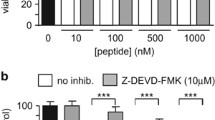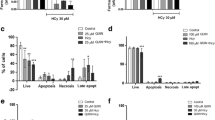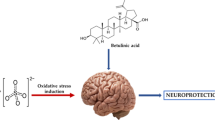Abstract
The extracellular microenvironment of the brain contains numerous biological redox agents, including ascorbate, glutathione, cysteine and homocysteine. During ischemia/reperfusion, aging or neurological disease, extracellular levels of reductants can increase dramatically owing to dysregulated homeostasis. The extracellular concentrations of transition metals such as copper and iron are also substantially elevated during aging and in some neurodegenerative disorders. Increases in the extracellular redox capacity can potentially generate neurotoxic free radicals from reduction of Cu(II) or Fe(III), resulting in neuronal cell death. To investigate this in vitro, the effects of extracellular reductants (ascorbate, glutathione, cysteine, homocysteine or methionine) on primary cortical neurons was examined. All redox agents except methionine induced widespread neuronal oxidative stress and subsequent cell death at concentrations occurring in normal conditions or during neurological insults. This neurotoxicity was totally dependent on trace Cu (≥0.4 μM) already present in the culture medium and did not require addition of exogenous Cu. Toxicity involved generation of Cu(I) and H2O2, while other trace metals did not induce toxicity. Surprisingly, administration of Fe(II) or Fe(III) (≥2.5 μM) completely abrogated reductant-mediated neurotoxicity. The potent protective activity of Fe correlated with Fe inhibiting reductant-mediated Cu(I) and H2O2 generation in cell-free assays and reduced cellular Cu uptake by neurons. This demonstrates a novel role for Fe in blocking Cu-mediated neurotoxicity in a high reducing environment. A possible pathogenic consequence for these phenomena was demonstrated by abrogation of Fe neuroprotection after pre-exposure of cultures to the Alzheimer’s amyloid beta peptide (Aβ). The loss of Fe neuroprotection against reductant toxicity was greater after treatment with human Aβ1–42 than with human Aβ1–40 or rodent Aβ1–42, consistent with the central role of Aβ1–42 in Alzheimer’s disease. These findings have important implications for trace biometal interactions and free radical-mediated damage during neurodegenerative illnesses such as Alzheimer’s disease and old-age dementia.





Similar content being viewed by others
Abbreviations
- Aβ:
-
amyloid beta
- AD:
-
Alzheimer’s disease
- Asc:
-
ascorbate
- BC:
-
bathocuproine disulfonate
- Cys:
-
cysteine
- DCF:
-
2′,7′-dichlorofluorescein
- DTNB:
-
5,5′-dithiobis(2-nitrobenzoic acid)
- FCS:
-
fetal calf serum
- Glut:
-
glutamate
- GSH:
-
reduced glutathione
- GSSG:
-
oxidized glutathione
- Hcys:
-
homocysteine
- ICP-MS:
-
inductively coupled plasma mass spectrometry
- MEM:
-
minimal essential media
- Met:
-
methionine
- MnTMPyP:
-
manganese tetrakis(1-methyl-4-pyridyl)porphyrin
- MTT:
-
3-(4,5-dimethylthiazol-2-yl)-2,5-diphenyltetrazolium bromide
References
Dringen R (2000) Prog Neurobiol 62:649–671
Rice M (2000) Trends Neurosci 23:209–216
Hillered L, Nilsson P, Ungerstedt U, Ponten U (1990) Neurosci Lett 113:328–332
Slivka A, Cohen G (1993) Brain Res 608:33–37
Li X, Wallin C, Weber SG, Sandberg M (1999) Brain Res 815:81–88
Wallin C, Weber SG, Sandberg M (1999) J Neurochem 73:1566–1572
Lindgren A, Brattstrom L, Norrving BH, Andersson A, Johansson BB (1995) Stroke 26:795–800
Grunewald RA (1993) Brain Res Brain Res Rev 18:123–133
McCaddon A, Davies G, Hudson P, Tandy S, Cattell H (1998) Int J Geriatr Psych 13:235–239
Miller JW (1999) Nutr Rev 57:126–129
Ho PI, Collins SC, Dhitavat SO, Ashline DA, Rogers E, Shea TB (2001) J Neurochem 78:249–253
White AR, Huang X, Jobling MF, Barrow CJ, Beyreuther K, Masters CL, Bush AI, Cappai R (2001) J Neurochem 76:1509–1520
Welch KD, Davis TZ, Van Eden ME, Aust SD (2002) Free Radical Biol Med 32:577–583
Wang XF, Cynader MS (2001) J Neurosci 21:3322–3331
Satoh K, Sakagami H (1997) Anticancer Res 17:2181–2184
Deibel MA, Ehmann WD, Markesbery WR (1996) J Neurol Sci 143:137–142
Atwood CS, Moir RD, Huang XD, Scarpa RC, Bacarra NME, Romano DM, Hartshorn MK, Tanzi RE, Bush AI (1998) J Biol Chem 273:12817–12826
Lovell MA, Robertson JD, Teesdale WJ, Campbell JL, Markesbery WR (1998) J Neurol Sci 158:47–52
Sayre LM, Perry G, Smith MA (1999) Curr Opin Chem Biol 3:220–225
Waggoner DJ, Bartnikas TB, Gitlin JD (1999) Neurobiol Dis 6:221–230
Bush AI (2000) Curr Opin Chem Biol 4:184–191
White AR, Cappai R (2003) J Neurosci Res 71:889–897
Cherny RA, Atwood CS, Xilinas ME, Gray DN, Jones WD, McLean CA, Barnham KJ, Volitakis I, Fraser FW, Kim Y-S, Huang X, Goldstein LE, Moir RD, Lim JT, Beyreuther K, Zheng H, Tanzi RE, Masters CL, Bush AI (2001) Neuron 30:665–676
Winterbourn CC, Peskin AV, Parsons-Mair HN (2002) J Biol Chem 277:1906–1911
Kress GJ, Dineley KE, Reynolds IJ (2002) J Neurosci 22:5848–5855
Stuerenberg HJ (2000) J Neural Transm 107:321–329
Gutteridge JMC (1984) Biochem J 218:983–985
Ciuffi M, Cellai C, Franchi-Micheli S, Zilletti L, Ginanneschi M, Chelli M, Papini AM, Paoletti F (1998) Pharmacol Res 38:279–287
White AR, Multhaup G, Galatis D, McKinstry WJ, Parker MW, Pipkorn R, Beyreuther K, Masters CL, Cappai R (2002) J Neurosci 15:365–376
Maynard CJ, Cappai R, Volitakis I, Cherny RA, White AR, Beyreuther K, Masters CL, Bush AI, Li Q-X (2002) J Biol Chem 277:44670–44676
Kaur D, Yantiri F, Rajagopalan S, Kumar J, Mo JQ, Boonplueang R, Viswanath V, Jacobs R, Yang L, Beal MF, DiMonte D, Volitakis I, Ellerby L, Cherny RA, Bush AI, Andersen JK (2003) Neuron 37:899–909
Hassett R, Kosman DJ (1995) J Biol Chem 270:128–134
Obata T, Yamanaka Y (2002) Arch Pharmacol 365:158–163
Zhou B, Westaway SK, Levinson B, Johnson MA, Gitschier J, Hayflic SJ (2001) Nat Genet 28:345–349
Robb SJ, Connor JR (1998) Brain Res 30:125–132
Minotti G, Aust SD (1987) J Biol Chem 262:1098–1104
Youngman RJ, Elstner EF (1981) FEBS Lett 129:265–268
Xu L, Koumenis IL, Tilly JL, Giffard RG (1999) Anesthesiology 91:1036–1046
Simonart T, Degraef C, Stordeur P, Noel JC, Mosselmans R, Van Vooren JP, Parent D, Boelaert JR, Heenen M, Galand P (2001) Free Radical Res 34:221–235
Gutteridge JMC (1992) Ann Neurol 32:S16–21
Moos T, Morgan EH (1998) J Neurosci Res 54:486–494
Dore S, Goto S, Sampei K, Blackshaw S, Hester LD, Ingi T, Sawa A, Traystman RJ, Koehler RC, Snyder SH (2000) Neuroscience 99:587–592
Huang X, Atwood CS, Cuajungco MP, Hartshorn MA, Tyndall J, Hanson GR, Stokes KC, Leopold M, Multhaup G, Goldstein LE, Scarpa RC, Saunders AJ, Lim J, Moir RD, Glabe C, Bowden EF, Masters CL, Fairlie DP, Tanzi RE, Bush AI (1999) J Biol Chem 274:37111–37116
White AR, Multhaup G, Maher F, Bellingham S, Camakaris J, Zheng H, Bush AI, Beyreuther K, Masters CL, Cappai R (1999) J Neurosci 19:9170–9179
Opazo C, Huang X, Cherny RA, Moir RA, Roher AE, White AR, Cappai R, Masters CL, Tanzi RE, Inestrosa NC, Bush AI (2002) J Biol Chem 277:40302–40308
Rottkamp CA, Raina AK, Zhu X, Gaier E, Bush AI, Atwood CS, Chevion M, Perry G, Smith MA (2001) Free Radical Biol Med 30:447–450
Bartzokis G, Tishler TA (2000) Cell Mol Biol (Noisy-Le-Grand) 46:821–833
Lee J-Y, Cole TB, Palmiter RD, Suh SW, Koh J-Y (2002) Proc Natl Acad Sci USA 99:7705–7710
Qian ZM, Wang Q (1998) Brain Res Brain Res Rev 27:257–267
Castellani RJ, Siedlak SL, Perry G, Smith MA (2000) Acta Neuropathol 100:111–114
Acknowledgements
This work is supported in part by grants from the National Health and Medical Research Council of Australia to C.L.M. and R.C. K.B. is supported by the Deutshe Forschungsgemeinschaft and the Bundesministerium fur Forschung und Technologie. X.H. is supported by grants from NIMH/NIH (5 K01 MH02001) and AFAR.
Author information
Authors and Affiliations
Corresponding author
Rights and permissions
About this article
Cite this article
White, A.R., Barnham, K.J., Huang, X. et al. Iron inhibits neurotoxicity induced by trace copper and biological reductants. J Biol Inorg Chem 9, 269–280 (2004). https://doi.org/10.1007/s00775-004-0521-8
Received:
Accepted:
Published:
Issue Date:
DOI: https://doi.org/10.1007/s00775-004-0521-8




